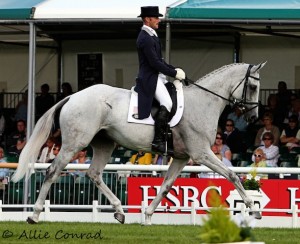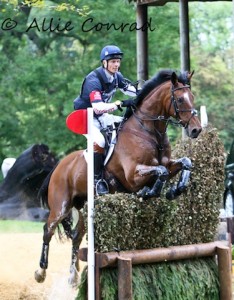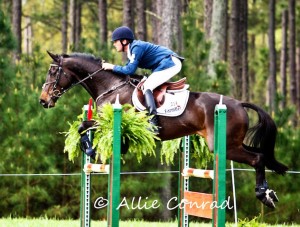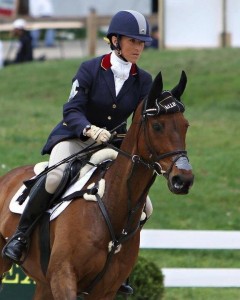On the day he was spotted in a cross-country warm-up ring, I Just Want to Fly looked about as far from his past as a failed racehorse could.
Dappled gray, and brimming with power and a showy presence, he moved flawlessly, capturing the eye of world-class equestrian Nathalie Pollard.
As Michael Pollard, her husband and Pan American Team Gold Medalist recalls, “She saw him across the ring and said, ‘That’s a really, really nice horse’. He just had a beautiful look and was already a good mover.”
During a phone interview this week, as he drove to the legendary four-star Kentucky Rolex, with I Just Want to Fly, now named Icarus, and some other mounts in tow, Pollard complimented his wife’s unerring eye for great horses, and waxed philosophical about a subject that has captured the imagination of riders of all ilk: ex-racehorse Thoroughbreds and the seemingly endless supply of world-class Sporthorse talent waiting to be uncovered at local racetracks.
Icarus raced four times in his youth at Prairie Meadows in Iowa, earning $540, before he was snapped up, and eventually found his way into the Pollard’s barn of top-level Sporthorses.
“I’ve had other OTTBs. I had a horse named S. S Jet from New Zealand, who I rode to the three-star level and who is going to Badminton this year. Before I could afford to go to England to get a horse, I would get a horse off the track,” Pollard says.
“If you find a good Thoroughbred off the track, they’re as good, or better, than anything you can find by going to Europe.”
This is exactly the point that so many top name riders, re-homing, and re-training advocates, have been trying to make for years; these equines are essentially a fiercely competitive Sporthorses. And they can win at the toughest competitions of all kinds, and at the highest levels.
No less than twenty-one ex-racehorse Thoroughbreds have received pinning numbers for Rolex Kentucky Three Day this weekend, and will compete against the crème de la crème in the highest rated show in the Western Hemisphere.
And, as they surge across hilly terrain, over steep obstacles, and into and out of water, filling their lungs with sweet Kentucky air as they gallop at speed, for 12 minutes, the dreams of their riders, and the hopes of Thoroughbred advocates, will fly along with them.
Allie Conrad, executive director of CANTER Mid Atlantic, and national board member, says the pendulum is swinging back toward the prominence of the Thoroughbred in sport.
Whereas, for years, it has been the high-priced, imported Warmblood that has dominated equestrian sport, Conrad believes a change is in the air.
“Is it a heyday? I think it’s the dawn of one,” Conrad says. “I think people are returning to the Thoroughbreds because they want a lighter, swingier horse with catlike quickness.”
While nobody is saying that the Thoroughbred will dominate the hunter/jumper world, or ever possess the gaits in great numbers of the dressage superstars, in the eventing world—where stamina, bravery and keen intelligence are paramount— the pendulum is indeed, swinging back, says three-time Olympian and world-renowned coach James C. Wofford.
“For my particular sport, I see a resurgence of the use of Thoroughbreds,” Wofford said in a telephone interview this week with OffTrackThoroughbreds.com.
“As Warmbloods were put to use in the upper levels” of eventing “it became apparent to some of the silverbacks of the sport, such as myself … that they could not meet the cardiovascular (rigors) … of galloping for 12 minutes, over obstacles, up and down hills.”
Even after a shorter eventing format was ratified by the International Federation of Equestrian sports in 2004, which reduced the endurance portion of the trials, cooler-blooded horses still lacked the stamina of Thoroughbreds, he adds.
“I do believe the pendulum is starting to swing,” Wofford says. The competitive factors combined with the bad economy have created the perfect storm of success for Thoroughbreds, Wofford says.
“People are paying phenomenally cheap prices for great horses,” he says, noting that if a horse can survive the mental and physical rigors of the track, and leave it with a “big, swinging walk,” and the spirit to try, that this is a horse with the right stuff.
“I might buy a horse because he has a huge walk,” he says. “The walk is the gallop, with a four-beat movement.”
Louder than hoof beats on a cross-country course, has been the drumbeat for racehorses, these days, coming loudly, from people like Steuart Pittman. The longtime equestrian really hit on something great when he started promoting the breed as a trainable Sporthorse, Wofford says, noting that Pittman does a “marvelous job” raising awareness about the breed and its potential.
Pittman, the mastermind behind the trailblazing Retired Racehorse Training Project, says a new heyday is coming.
“In five years, the number of Thoroughbreds at Rolex will be even higher than it is now,” says Pittman, creator of the training project. And it’s easy to see why. In his re-training experiment earlier this year, four ex-racehorses proved willing, trainable and smart.
Just weeks after being paired with equestrians, the horses learned to walk, trot and canter, gamely demonstrating their talents in a ring with 3,000 onlookers pressed against the rails.
They proved themselves there, and they’re proving themselves at the highest levels.
“In Rolex, you still need a horse who can make the time. And you need one with a catlike quickness, who has the reflexes to get you out of trouble if you make a mistake,” he says. “I feel safer on a quick-thinking Thoroughbred any day of the week.”
With so many great Thoroughbreds to watch at Rolex this weekend, Pittman declined to make a choice. Courageous Comet, owned and ridden by Becky Holder, will of course be hard to beat, he says, And Icarus, ridden and owned by Michael Pollard is a big talent. So is Parklane Hawk, ridden by William Fox-Pitt, and unraced Thoroughbred Andromaque, ridden by Will Faudree.
Anthony Patch returns this year with owner and rider Lainey Ashker and Pam Fisher will be riding ex-racehorse stallion Sea Lion II. Please visit Retired Racehorse Training Project for a complete list of OTTBs at Rolex.
Each horse/rider team has so much riding on them. To make the best time and get the best scores at the three-day event is, naturally, the prime motivation.
But, as Kentucky gears up for its most important week, which begins with Rolex and concludes with the Kentucky Derby on May 5, there is a buzz, and an excitement about the ex-racehorses who never won at Churchill Downs, but who are at the top of their game, just down the road from the Twin Spires.
“It’s a great thing we’re doing in Kentucky,” Pollard says.






I LOVE, LOVE, LOVE this piece and your writing/reporting! There is SO much talent coming off US tracks! With superb breeding, athleticism, stamina and willingness to learn and drive to WIN. To think that these quality animals are not being brought to their potential is HEART BREAKING. But to hear about, see and personally experience OTTB’s being successfully rehomed and re”jobbed” is fantastic; to see it happening on a larger scale, with promotion of the breed and awareness being spread by such big names, on such a large scale, is beyond fantastic! I don’t know why more people don’t buy and ride or compete OTTB’S; it’s not like buying one is a complete charity case…you’re getting a quality animal at a killer price! AND you’re improving the life of an animal who may otherwise be cast aside (for GOD KNOWS WHY!?) so it’s really a win win! I LOVE my OTTB’s and will continue to ride and support OTTBs in any and every way I can!
Thanks for the wonderful article on OTTBs, it does make me quite teary. Like Pollard mentioned, many amateurs couldn’t afford expensive horses when we were younger so we bought TB instead.
I’ve had two TB both off the track. My older retired TB was probably made for eventing but didn’t have alot of scope. He did hunter/jumpers but was happiest in the event field. Now at the age of 19 or 20 he’s been teaching really little kids and some older adults to ride for the first time. He also may become a therapy horse at a local therapy farm in Wisconsin called Lifestriders. He loves being groomed and doted on by little girls. I provide an endless supply of carrots so he’s pretty content these days.
The difficulty, though, is that there are SO many horses out there, and a lot of them, while having the heart and athletic ability and stamina and intelligence to do the job, simply do not have the physical bone/tendon strength to do it without breaking.
I have a wonderful, fabulous OTTB (actually, two of them, but one is now 25 and retired) who would be an incredible eventer. He’s got almost perfect conformation, the desire, the quickness and the jump. His front legs, however, simply can’t hold up to the jumping. Slightly upright pasterns, light cannon bones and low heels in front = stem cell on his tendons and a new career in dressage. Where are the iron horses? My older horse is built like a warmblood and raced for 9 years. I would LOVE to find another like him, but haven’t seen one anywhere who didn’t have the front legs of a deer.
So, so thrilled the Thoroughbred is making a comeback in eventing…it’s a sport MADE for the Thoroughbred. About six years ago I was able to go to watch Rolex and was quite disheartened to see so many warmbloods on the roster, and so few OTTBs. Sure, warmbloods excel in dressage, but the thoroughbred, oh, the Thoroughbred SHINES on cross country because they are in their element: Wily, smart, brave, quick and strong. I’d trust a Thoroughbred to pull our butts out of the fire on a tough question any day of the week!
Jenn,
How cool that you went to Rolex. Next year, I will be there! There are still more Warmbloods competing, but, there is the opinion of the experts — Allie Conrad just posted Thoroughbreds are the “new black”– that there is a comeback. I hope all the TBs do a great job this year, and make the best times!!
Jenn, while I’m thinking of it, could I do a story about you and your blog? I’d love to interview you. My email is s.salk@offtrackthoroughbreds.com. Sue
While I am exceptionally thrilled that the OTTBs are finally coming into their own spotlight, which is well deserved, there is one TINY little problem. In order to have OTTBs you have to have racing. What industry is in major trouble in the United States? Oh yeah, that’s right racing. The racing industry STILL does not believe nor embrace the public or the fact that these horses are WANTED. While I am thrilled that the OTTBs are finally getting their due (again) I am left to wonder when will the racing industry catch on?
Hi BK,
Thanks for writing in to my site. I appreciate it. Although I cannot speak to the business of racing, the “industry” itself, I am of the impression that the racetracks working individually with rehoming/retraining organizations, trainers, jockeys, exercise riders, etc., are trying very hard to find second careers for their horses. I only have first-hand experience with one racetrack, and, I have seen how well they work with CANTER, and as individuals, to help horses find a soft landing somewhere. And, overall, I feel hopeful with the work being done by the NTRA and Jockey Club to help promote the breed, and address aftercare. So, I guess I see the glass as being half full with regards to the racing industry, and filling up. If that analogy makes sense. 🙂
What a beautiful piece… I love your blog and intend to continue following.
I completely agree that there are so many fantastic horses at the track… I am lucky to own one of them. He is as smart, talented, and athletic as any horse I have ever met. His limiting factor: his rider!!
I actually got choked up reading this piece…I have such pride in OTTBs and what they can accomplish if only given the chance. The camaraderie and support of other OTTB owners in the event world becomes a family of sorts. I will be cheering Michael, Lainey, Will and so many others on this weekend, and I am SO excited about where the next few years will take us in our sport! Thanks so much for highlighting this, Sue!
KC, I know what you mean about feeling a little teary eyed. I was too, after talking with the people who are doing so much for the breed. I love it! And, I’ll be rooting for all of those OTTB/rider teams!
Leah: What a huge compliment, thank you. I’d like to hear more about your OTTB, so if you’re interested, please email me at s.salk@offtrackthoroughbreds.com.
And, TB Dancer, you speak truth! Thank you for taking the time to write in like you do. It always makes my day to see your notes. 🙂
OTTBs come with thousands of dollars worth of training. They are eager to learn. Some, like the one I own, need a patient trainer when they move off the track to their new career. I took things slowly with him because I wasn’t sure I was doing things correctly. He worried about doing the WRONG thing because he is VERY eager to please. He did not want to make a mistake. We were perfectly matched (divine Providence maybe?) At any rate, I’m thrilled to read this particular entry, Susan, because I agree with you–there IS a place for these youngsters who are no longer competitive or who just don’t like racing. They need “groceries and a job to do” and will excell, if not in eventing, in perhaps one or the other of the parts of the three-day–dressage or stadium jumping (or they have the style for the hunter arena). The more exposure these horses get, the greater the market for them, and the more incentive to go the TB route when looking for your next horse.